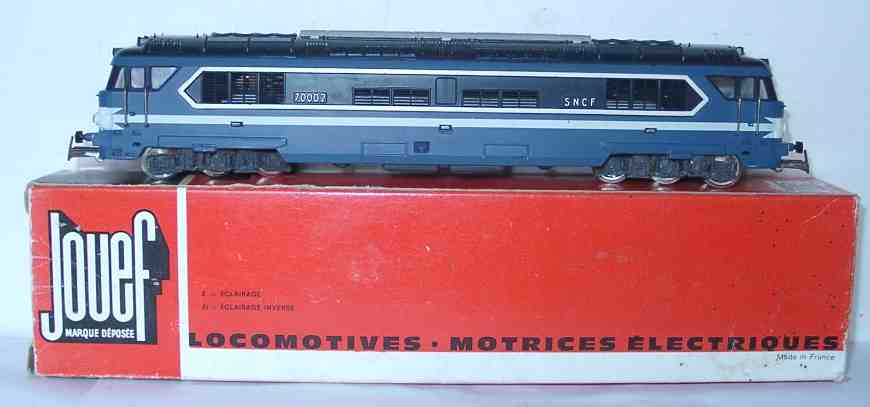

8561 - the SNCF co-co diesel electric 70002
Prototype information:
|
In the mid 1960's the SNCF was seeking a single-engine diesel locomotive of 4,000 h.p. or more. Recent experimental 4,000 h.p. designs now running on the SNCF are the two MTE 82-ton diesel-hydraulic BB69000s with Voith transmissions (see the June, 1964 issue) and the two Alsthom 112-ton diesel-electrics, CC 70001 and 70002 with the two diesel engines driving the rotary windings of an alternator in different directions (December, 1964 issue). Both types develop 4800 h.p. and a 5,750 h.p. locomotive could be developed from the diesel-hydraulic BB69000. Reports differ as to the performance on test of CC70001-2, but SNCF policy for high-power diesel traction in the near future is tending towards more conventional designs. The alternator /rectifier principle has already proved itself in the converted BB locomotive 67036 (MODERN RAILWAYS, August, 1965) and this system associated with a single medium-speed engine rather than the two high-speed engines and bi-rotor alternator of the prototypes has been chosen for the next step towards higher powers. Orders for a 3,600 h.p. C-C locomotive to be known as Class CC72000 have already been placed with Alsthom and further orders are expected this year. Alsthom is using the AGO V-16-B diesel engine, capable of giving 4,000 h.p. if required. The design of these locomotives conform with the SNCF policy of simplifying and standardising the details of its diesel and electric motive power so as to reduce costs by allowing as many as possible of the same transmission and mechanical components to be used in both. Meanwhile, the prototypes 70001 and 70002 have given practical experience of a method of diesel-electric transmission which might still be important if powers greater than those obtainable from single engines of practicable size for locomotives were to be demanded. The SNCF considers that the bi-rotor alternator would enable powers of over 6,800 h.p. to be installed- a zone hitherto considered practicable only with gas turbines. A characteristic of the prototypes which has emerged during their trials has been their efficiency in low- speed, high tractive effort conditions, when figures between 88 and 90 per cent have been recorded in the dynamometer car . This has meant powers at the wheel rims of 4,000-4,100 h.p., comparing well with electric locomotives, although the conditions are normally unfavourable to diesel-electric transmission. A 675-ton train has been hauled on a I in 100 gradient with a drop in speed only from 82 to 75 m.p.h.; and with 435 tons the journey from Paris to Nancy has been made at an average speed of 82 m.p.h.
|
|
No: Built : |
2 |
Prototype CC70001 SNCF |
|
Operating area : |
East region | |
|
Number range: |
70001 - 70002 | |
|
Power: |
4800 HP | |
|
Maximum speed: |
140 km/h (90 mile/h) | |
|
Weight: |
117 tonnes | |
|
Manufacturer: |
Alsthom | |
|
Date entered service: |
1965 |